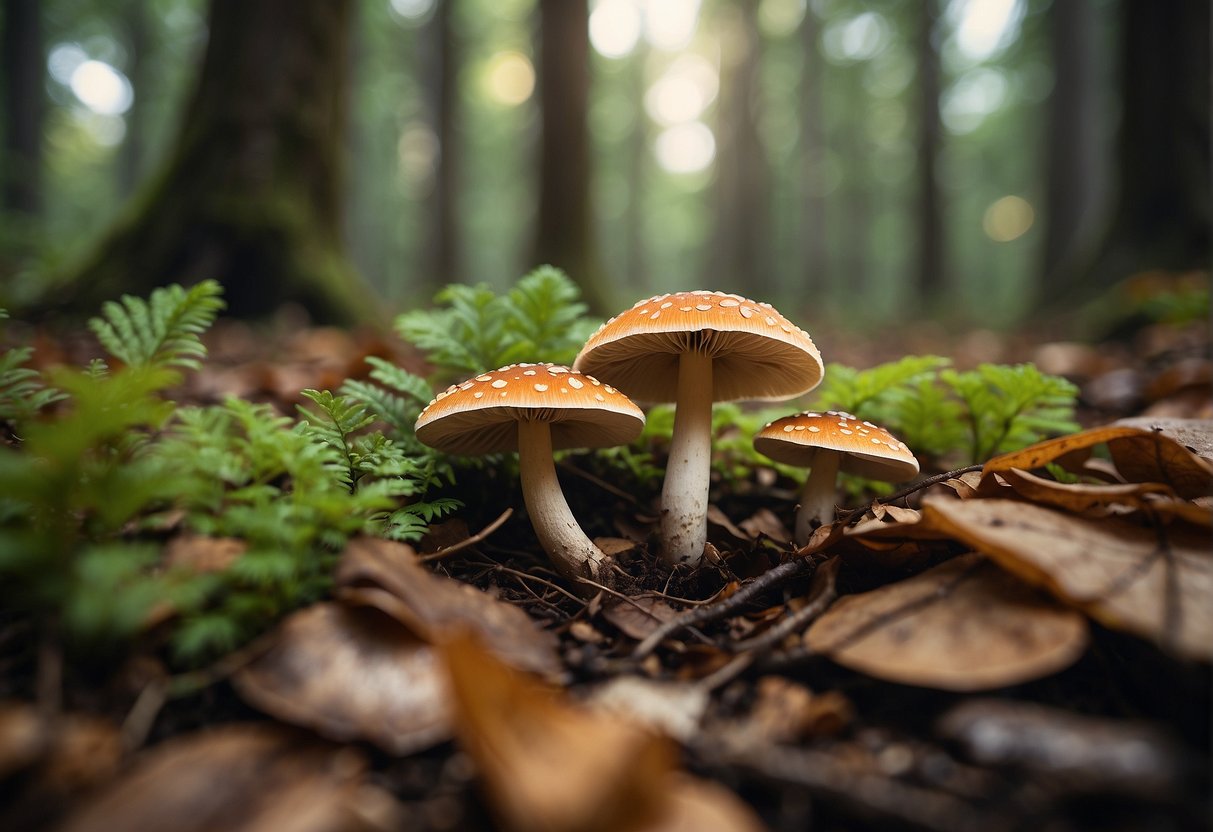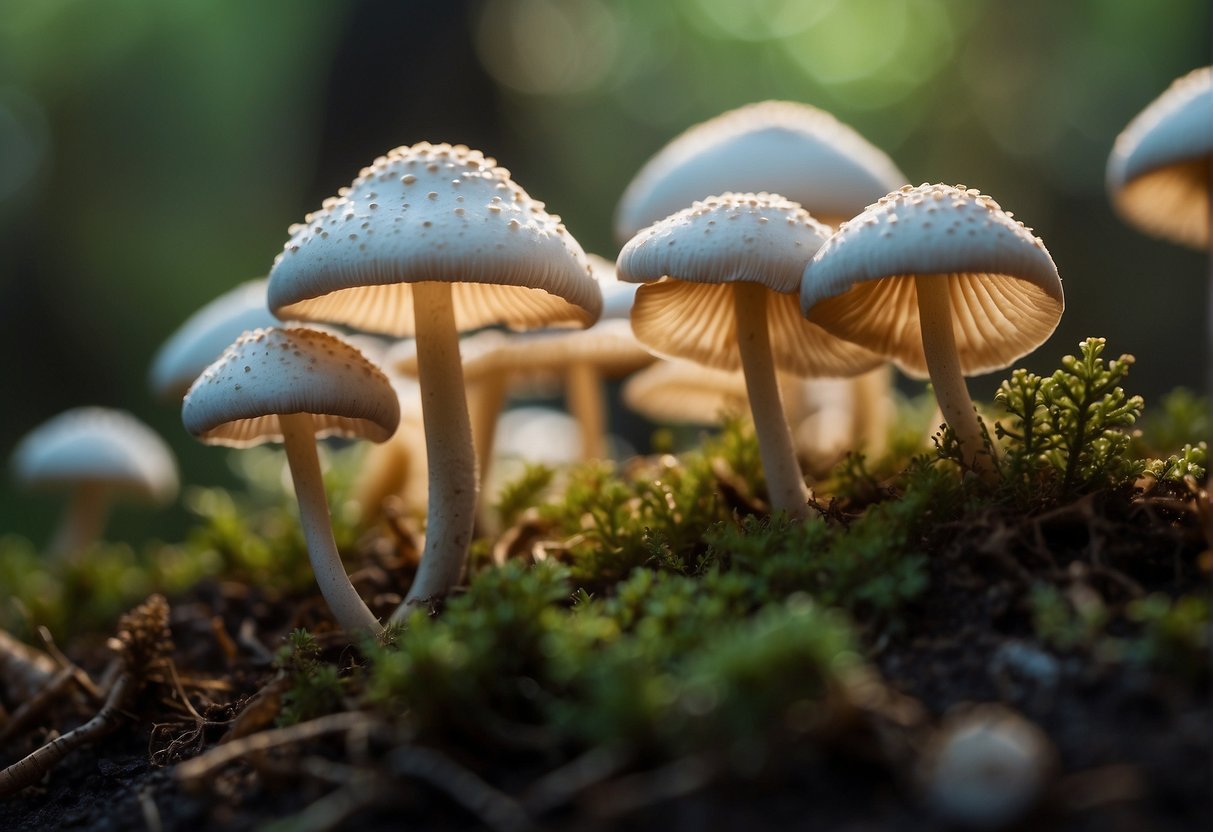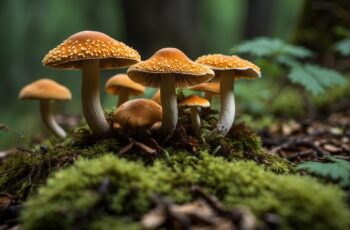Fruiting mushrooms mark a fascinating phase in mushroom cultivation, one that signifies the transition from the vegetative growth to the production of actual edible fungi. If you’re a beginner eager to venture into the world of mycology, understanding how to grow mushrooms is essential for a successful harvest. It’s a process that ties closely with nature’s own methods but under controlled conditions that you manage. This methodical task, mirroring the cyclic patterns found in forest ecosystems, allows for cultivation of various mushroom species right at your doorstep.

Focusing on mushroom cultivation, particularly the fruiting stage, involves maintaining specific environmental conditions. Appropriate levels of humidity, temperature, light, and carbon dioxide are crucial to mimic the natural habitat where mushrooms thrive. It’s not just about providing care; it’s about creating an ecosystem where the fungi can flourish. Patience and attention to detail are your trustworthy companions on this rewarding journey.
In learning how to grow mushrooms, practical knowledge goes hand in hand with hands-on experience. As you progress, you’ll discover the satisfaction of nurturing growth from spawn to full-blown fruiting bodies. Whether it’s in a small outdoor patch or in containers within your home, the principles remain the same. With time, you’ll develop a deep connection to the process, understanding the subtle cues mushrooms give as they develop. Get ready for a gratifying adventure into the heart of mushroom fruiting.
Fundamentals of Mushroom Cultivation

Mushroom growing is both an art and a science, requiring a thorough understanding of mushroom biology and meticulous attention to detail in preparing essential materials and selecting strains. Equipping yourself with the right knowledge will lead to a rewarding harvest.
Understanding Mushroom Biology
Mushrooms are the fruiting bodies produced by mycelium, a network of fungal threads which comprise the main part of the fungus. Your success hinges on sustaining a thriving mycelium. This mycelium feeds on the substrate, a base material you’ll provide, such as straw or wood chips, chosen for its nutrient content and water retention. As the mycelium consumes the substrate, conditions must be ideal to stimulate the next phase: fruiting.
Essential Materials and Equipment
Your toolkit for cultivation should include these basics:
- Grain spawn: A propagation material inoculated with mushroom spores or cultures. Think of it as seed for mushrooms.
- Substrate: Specific to your mushroom species, frequently sterilized to prevent contamination.
- Humidity and Temperature Control: To foster a suitable growing environment.
- Spray Bottle: Keeps humidity at the desired level for certain stages of growth.
Remember to maintain cleanliness at all times to avoid contamination disrupting your mycelium’s health.
Selecting Suitable Strains
Choose strains that match your environment or that you can realistically replicate conditions for. Some strains prefer the cooler, moist climate akin to a forest floor, others the warm decay of a compost pile. Study the spores or cultures you’re interested in, grasping their specific needs for temperature, humidity, and lighting. Are they woodland mushrooms that relish the shade, or varieties that require more sunlight? Select wisely, as your strain choice underpins the entire operation.
Creating the Ideal Fruiting Environment
Creating the ideal environment for mushroom fruiting requires precise control of various factors such as temperature, humidity, and air exchange. Proper lighting also plays an essential role. Making sure these elements are just right can help ensure a successful harvest.
Temperature and Humidity Control
Mushrooms flourish when the temperature and humidity are within a certain range. You need to maintain a temperature usually between 60°F to 80°F (15°C to 26°C) and a humidity level around 80% to 90% for optimal growth. Use a reliable hygrometer to monitor these conditions.
- Ideal temperatures: 60°F to 80°F
- Ideal humidity: 80% – 90%
Adjusting your humidifier settings can help maintain these levels. Remember, consistent conditions lead to healthier, more plentiful mushroom crops.
Ventilation and Air Exchange
Good ventilation is key for a productive fruiting chamber. Your mushrooms need fresh CO2-rich air to trigger fruiting, and that’s where fresh air exchange comes into play. Aim to cycle in fresh air several times a day to maintain a CO2 level below 800 ppm. An adequate air exchange system will help you keep this balance.
- Fresh air exchange: Minimum 3-5 times per hour
- Keep CO2 levels low for better fruiting
Lighting and Light Cycles
Mushrooms require less light than plants, but they do need some to form proper fruiting bodies. Provide your mushrooms with indirect light for about 12 hours a day. It shouldn’t be too intense—think of the soft light of dawn or dusk that filters through the trees during a forest hike.
- Light Duration: ~12 hours of indirect light
- Light Quality: Soft, diffused, natural light equivalent
Proper lighting will simulate the natural environmental conditions they’d get in the wild, encouraging healthy fruit development.
Cultivation Techniques
Mushroom cultivation can be a rewarding outdoor hobby, and understanding the specific steps involved is key to a successful harvest. Let’s explore the essentials: from laying the groundwork with sterilized substrate to sparking the growth with precise fruiting conditions.
Preparing and Sterilizing Substrate
The foundation of any successful mushroom cultivation is the substrate. Your substrate acts as a nurturing soil for your mushrooms, and it’s critical to prepare it right. Begin by choosing a substrate suited to your mushroom species—options like sawdust, straw, or wood chips are common. Sterilization is paramount to prevent contamination; you can use methods such as pressure cooking or steam pasteurization to eliminate unwanted organisms. Ensure that your substrate has an adequate nutrient content to support mushroom growth.
Inoculation and Incubation
Inoculation involves introducing mushroom spores or mycelium (the mushroom’s vegetative growth) into your sterilized substrate. This process should be done in a clean environment to prevent contamination. After inoculation, the substrate needs to be kept in a dark place at the correct incubation temperature, which varies depending on the mushroom species. Typically, you’ll need to wait a few weeks for the mycelium to colonize the substrate fully before moving to the fruiting phase. Patience is crucial during this stage, as rushing can lead to a poor yield.
Inducing Fruiting Conditions
Once the substrate is fully colonized, it’s time to initiate the fruiting process. The conditions need a significant change to signal to the mycelium that it’s time to produce mushrooms. Humidity and temperature are the critical factors here. You can use a monotub method or a shotgun fruiting chamber—both are effective for creating a microclimate with high humidity and proper fresh air exchange. Pay close attention to moisture levels and air quality; these parameters can make or break your mushroom crop. With consistent monitoring and a little bit of outdoor finesse, you’ll soon see the fruits of your labor.
Harvesting and Post-Cultivation Practices
In the delicate stages of harvesting and post-cultivation, your precision and attentiveness can greatly impact the quality and yield of your mushroom crop.
Recognizing Harvest Time
When it’s time to harvest, mushroom pins—the small, nascent mushrooms—should be closely observed. You’ll know the fruiting stage is imminent when you see pin formations begin to expand and the caps start to separate from the stem. For most mushroom strains, this signals that harvesting is due within the next few days.
Post-Harvest Handling and Storing
After you’ve harvested your mushrooms, post-harvest handling is critical to maintain their quality. Ensure mushrooms are kept at a cool temperature, ideally between 2°C to 4°C, to maximize shelf life. For storing mushrooms, it’s recommended to use paper bags or breathable containers to prevent moisture build-up which can lead to spoilage.
- Storing Guidelines:
- Keep cool at 2°C to 4°C
- Use breathable storage
- Avoid excess moisture
Troubleshooting Common Issues
Encountering problems post-cultivation can be common, but don’t be discouraged. If your yields are low, inspect your cultivation process for issues like inadequate moisture or contamination. When troubleshooting, be meticulous in your approach—small changes can make a significant difference in subsequent flushes. Remember, each mushroom strain may require tailored care due to their unique characteristics.


